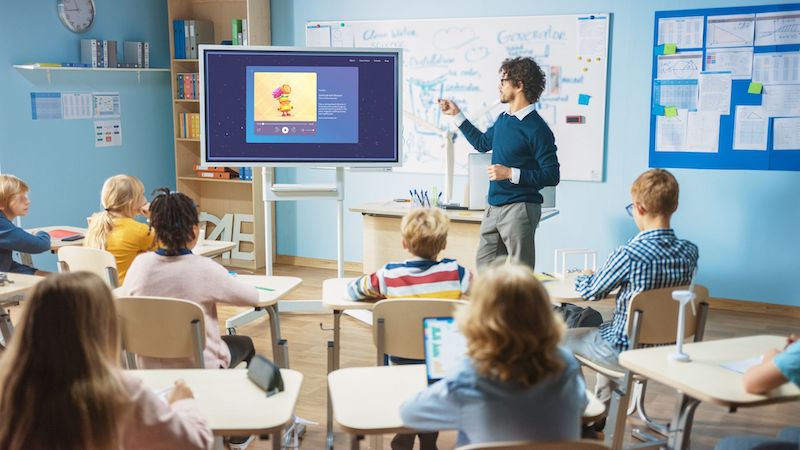
- 3 mins
5 Ways Moshi Can Help You Manage Your Classroom

One of the most intimidating aspects of teaching, according to many educators, is classroom management. At its most challenging, it may bring about visions of a strict school administrator instilling fear and resentment in students or an overwhelmed teacher unable to control their unruly class. These two extremes can absolutely be true. However, neither captures the purpose and effectiveness of realistic classroom management.
There are two overall aims of classroom management: establishing a calm environment to facilitate meaningful learning of a subject and contributing to students’ social and moral development, which in turn supports their academics (Doyle, 1986). According to a study by American researchers, the teacher’s management skills, personal qualities, and relationships with students are important factors that are crucial to successful learning (Stronge et al., 2011).
In my own experience, I have learned that not only is every class different, but every student is different. This does not mean that students need individual rules and expectations, but it does mean that often the style of communication has to be adjusted. Just as it does with any adult we interact with. Your students are people. They have good and bad days, energy fluctuations, and their own personal stresses. All these factors can contribute to behavior challenges. Acknowledging positive behavior is one of the most helpful things one can do to curtail distractions and negative educational environments.
A student’s behavior in class is a result of the teacher’s environment. You may have seen a group of students who learn and behave well for one teacher and not as well for another. This is a direct result of the teacher. It is the responsibility of the educator to create a safe environment for their students.
First, a teacher must be seen as an authority figure. Presenting yourself in an authoritative manner helps to gain the respect and trust necessary to lead students. Have confidence in your authority and your teaching. Stand strongly but openly, with a welcoming presence that encourages engagement in learning. Speak clearly, directly, and with conviction. Maintain composure and avoid becoming flustered or angry, as this is a sign of lack of control. Use positive language such as “I see you’re choosing to . . .” or “Right now we are working on . . .”, rather than commanding language such as “Don’t do that” or “Stop talking now”. Using a calm but strong voice and maintaining control are key. Many times, I start by acknowledging and thanking students who are meeting expectations and getting on with their work. This indirectly drives those who are not doing so to begin following suit.
I’ve also learned some tricks by trial and error. I’m a 5’4” woman and many of my male students are much taller and bigger than I am. I noticed that when I give instructions sitting behind my desk, my presence is less authoritative. However, when I stand in the center of the room or circulate throughout while they are sitting at their desks, my presence is stronger and more effective. Because we have built a trusting and honest relationship, I usually crack a joke about having to stand up to be noticed in a room full of giants. They take it as a compliment and it gives them pause to realize that perhaps they weren’t paying enough attention to the teacher in the room.
When students have a common ritual in your class, they can rely on it and not experience confusion about expectations. For example, it is my school’s policy that students line up outside the door and wait to be let into the classroom by their teacher. I greet them at the door in order to engage with them, say “Good morning” or “Good afternoon,” and ask them how they are. My students like to give me handshakes or fist bumps. My warm smile and welcoming nature show them I’m happy to see them and excited for us to explore the lesson together.
Once inside the classroom, they collect their exercise books if I haven’t laid them out already, write the date and title of the lesson, and begin their “‘Do It Now”’ warm-up task in silence. This usually takes about 10 minutes while I take the role. When the lesson is over, they are expected to put their workbooks away and any supplies they have used and leave the classroom clean and tidy for the next group. I remind them of this by giving verbal requests and recognition. I’ll always tell my students to have a great day and give them compliments as they go. This could be on their work, behavior, demeanor or anything. I want them to leave in a positive and happy mood.
Students want to belong, feel empowered, and enjoy themselves. The classroom environment needs to be safe physically, mentally, and emotionally. Students need quiet to learn effectively, and some are more sensitive to low-level disruption than others. The classroom should be clean and well organized and allow for some respected areas of personal space. Post the school’s policies surrounding behavior and consequences in your room and refer to them as a way to reinforce and help students remember expectations.
Encourage students and compliment them when you see they are doing well and meeting classroom expectations. I have a pretty good relationship with most students and can see that some get fidgety and need a walking break. They may not always have a “time-out” card for this but I don’t restrict them. I allow them a minute or two to stand out of the room to regulate themselves if I think they are getting disruptive to themselves or others.
I recently reorganized my desk layout, as I noticed that many of my tall students were inadvertently kicking each other under tables or feeling crowded due to the groupings, which led to distractions. After rearranging the desks, I saw an immediate drop in disruption and distraction. The students seemed much more focused and comfortable with more of their own space. I also am very quick to shut down banter that goes too far. If it is rude or harsh, I acknowledge it and encourage apologies as well as positive and polite speech between students.
One of my favorite things to do is acknowledge students’ contributions to a discussion or complement their written work if they have shared it with the group. I encourage others to be positively vocal and encouraging as well. Having their hard work recognized in this way helps build trust and respectful relationships among students.
Classroom management doesn’t have to be scary and overwhelming. It can be a positive experience that cultivates trust, caring, and a thirst for knowledge. In each small moment of success, I am reminded of why I chose the best profession in the world!